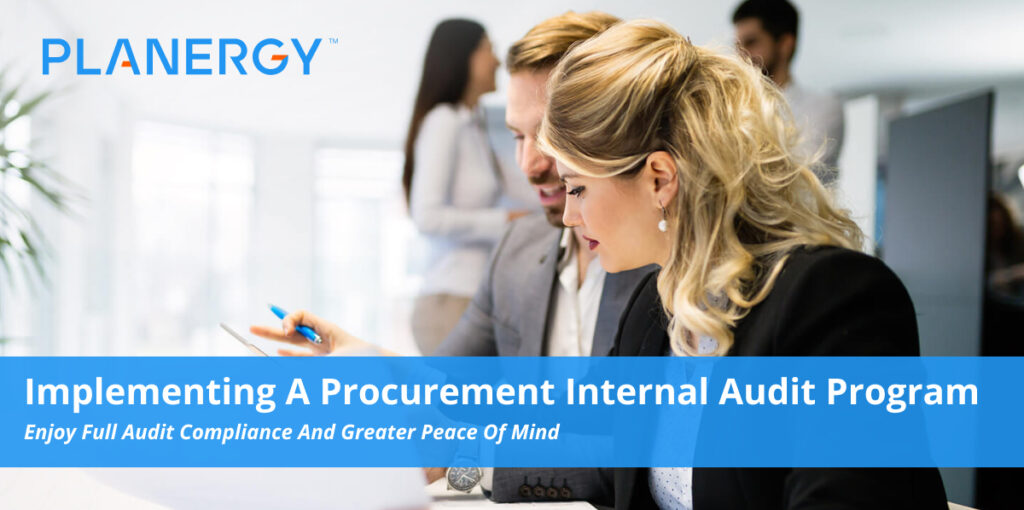It may not get as much attention as marketing, sales, or R&D, but your procurement department is a crucial part of your company’s success. The efficiency and efficacy with which your procurement team manages sourcing and connects with other departments such as accounts payable, production, and finance can have a major impact on your company’s strategic decision making, compliance, and ability to compete in a crowded global marketplace.
If you’re not measuring, or even tracking, your procurement performance, you’re missing out on more than just data. A procurement internal audit program allows you to review and analyze your procurement procedures in order to: identify areas in need of improvement; ensure compliance with internal controls, industry standards, and legal requirements; and reduce risk, fraud, and waste through procurement process optimization.
Why You Need a Procurement Internal Audit Program
From purchase orders to contract management to supply chain issues, your purchasing department can be a goldmine of strategic insights and productivity—or a minefield of impending disaster. To ensure it’s the former, you need a procurement audit to document, measure, and evaluate how well your internal controls and procurement methods function.
An internal audit benefits your company in four ways:
- Clarity, Transparency, and Objectivity.
Just as it would be folly for employees to give their own performance reviews, trying to evaluate the purchasing department from within will likely be both a fruitless labor and a glaring conflict of interest. An internal auditor (or assembling an internal auditing team), cross-trained in procurement but from (an)other department(s), provides a complete and accurate review of procurement activities and procedures while ensuring objectivity.
- Process and Operational Efficiency Gains
Audit procedures introduce continuous monitoring and review to your workflows, bringing continuous improvement with them. Every roadblock removed and process optimized is another step toward optimal performance, reduced risk, and a healthier, more profitable business.
- Risk Management
Internal audit procedures support effective risk assessment and management by exposing risk generated by sub-optimal purchasing processes, rogue spend, compliance failures, and fraud. A formal audit program also improves documentation, making follow-up easier and allowing you to pursue continuous improvement with consistent and clear benchmarks for corrective actions.
- Improved Compliance
Internal audits provide immediate benefits to compliance by verifying your internal controls and procurement policies (as well as the performance and policies of your vendors) are in line with your own policies, industry standards, and legal requirements. However, they also provide reassurance for external audits by supporting (through the formalization of procurement practices) a solid, clear, and accurate audit trail.
As with the procurement process itself, audit procedures will vary from one company to another. However, every company can benefit from an internal audit process that breaks procurement activities into manageable categories and then reviews the procurement processes related to each in order to establish which are working and which require corrective action.
Procurement Internal Audit Program Essentials
As with the procurement process itself, audit procedures will vary from one company to another. However, every company can benefit from an internal audit process that breaks procurement activities into manageable categories and then reviews the procurement processes related to each in order to establish which are working and which require corrective action.
- Develop a Checklist
Developing a checklist approach is helpful in two ways. Firstly, it allows you to break down your procurement function into its component parts and establish visibility into all of your processes. Secondly, that same breakdown of procurement practices provides a framework for internal controls and procurement policies implemented through the use of a cloud-based, automation-driven procurement software solution.
A sample checklist for your procurement internal audit program might look like this:
PURCHASE ORDERS
- Review purchase order creation workflows.
- Are manual processes still being used?
- Are contingencies in place for emergencies?
- What internal controls are in place to prevent rogue spend, theft, and fraud?
- Review a random sample of purchase orders for completeness and accuracy.
- Verify three-way matching is being used consistently and correctly.
- Verify every purchase order has proper authorization.
- Who is authorized to make purchases based on budget, department, item categories, etc.?
- Which purchases require special additional authorization, if any?
- Has separation of duties been used to prevent a conflict of interest between the roles of buyer and approver to minimize risk?
VENDOR SELECTION AND EVALUATION
- Review essential goods and services, particularly those set as sole-source, for potential risk exposure.
- Review established criteria for approved suppliers.
- Check references.
- Review performance and compliance history.
- Evaluate requirements for compliance, price, quality, and reputation.
- Identify vendors with particular promise for essential goods and services or favorable customer service, pricing, and terms.
- Review vendor onboarding process, both long-term and project-specific.
- Review contract management procedures and processes and ready availability of necessary contract data to all stakeholders across the procurement function and beyond.
- Review vendor selection procedures, including the bidding process, for new or project-specific purchases sourced via request for proposal (RFP).
- Identify any non-compliant purchasing behaviors or non-standard purchases with unapproved vendors.
- Periodically perform a detailed review of existing supply chain to ensure full vendor compliance with legal, industry, and contract requirements.
RECEIVING
- Review receiving processes for accuracy and completeness.
- Conduct a walk-through to verify receipt of physical goods connected to shipping documents, purchase orders, and invoices.
- Ensure three-way matching is being used consistently and correctly.
- Review exceptions and identify potential areas for corrective action to optimize workflows and procedures.
INVOICING AND PAYMENT
- Review invoice processing workflows for completeness, accuracy, and adherence to internal controls related to processing time, exceptions, and corrections.
- Review exceptions and identify potential areas for refinement and correction.
- Ensure three-way matching is being used consistently and correctly.
- Flag instances of invoice fraud, duplicate payments, inaccurate or fraudulent disbursements, theft, and maverick spend for special investigation and correction.
- As with purchase orders, verify conflicts of interest are prevented through proper segregation of duties.
AUDIT REPORTING
- Prepare both a detailed audit report and executive summary of findings.
- Identify problem areas and provide suggestions for corrective action that improves process efficiency, reduces risk, ensures compliance, etc.
- Create a schedule of follow-up audit testing to ensure suggested improvements have been implemented.
- Embrace Automation
If tackling an internal procurement audit seems daunting, take comfort in the knowledge that a single change can make the entire process infinitely easier. Choosing an automated, cloud-based procurement software solution like PLANERGY takes the strain out of audit work by streamlining and automating most of the processes involved.
With artificial intelligence, centralized document management, and improved collaboration and communication through the cloud, all of your procurement workflows will be visible and ready for real-time review and optimization whenever you like.
Customized catalogs and complete supply chain management tools make it easy to create a closed system where all of your goods and services are ordered from the best vendors, at the best pricing and terms, with full transparency for financial analysis, reporting, and forecasting. And with everyone “shopping” inside the same system and using the same workflows (including automatic three-way matching!), rogue spending, theft, and invoice fraud are greatly reduced or eliminated.
Automated approval workflows let you create as many contingencies and reminders as you need to keep purchase orders and invoices moving, so you don’t run into production delays or lose valuable discounts (and goodwill with your suppliers) through late payments. Stakeholders can access and approve documents from anywhere via the mobile app, too.
Automation eliminates wasted resources, human error, and needless, costly delays, too.
- No more expensive and time-consuming data entry.
- No more expensive paper document storage.
- No more missing out on essential goods and services or struggling to maintain adequate cash flow for both necessary purchases and innovation.
- No more inaccurate, risk-creating errors in forecasting and strategic decision making due to opaque spend.
- No more nasty surprises that can damage your company’s profitability, reputation, or future.
Ultimately, investing in automation is the first step to sleek, productive procurement that runs on continuous improvement—instead of playing catch-up.
Internal Procurement Audits Save You Time, Money, and Frustration
To reap the value hidden in your procurement department, you need to know how to review and optimize its processes. By developing an effective internal audit program and taking advantage of the power and versatility of procurement automation software, you’ll be able to monitor and refine your procurement in real time, and ensure your company’s purchasing function is efficient, compliant, and generating an optimal return on investment.




